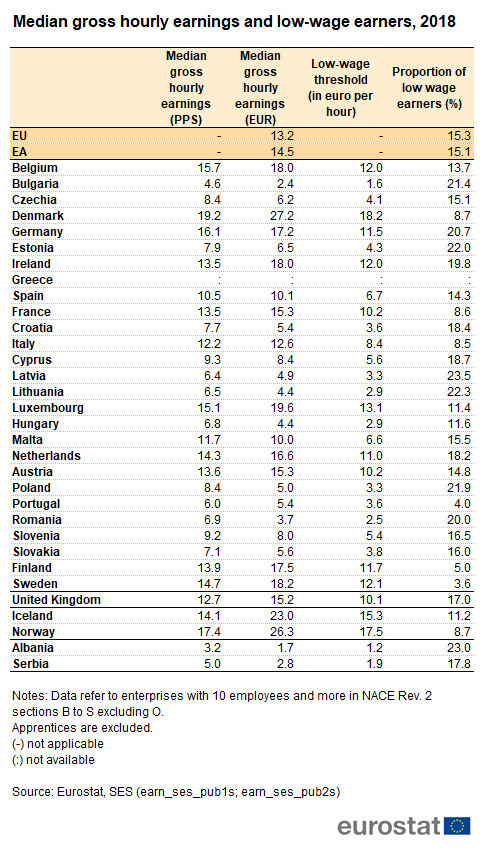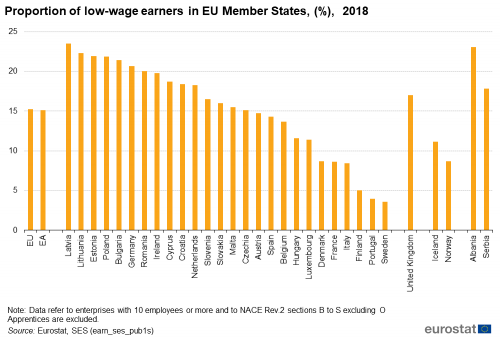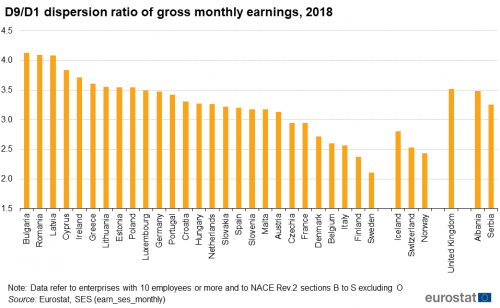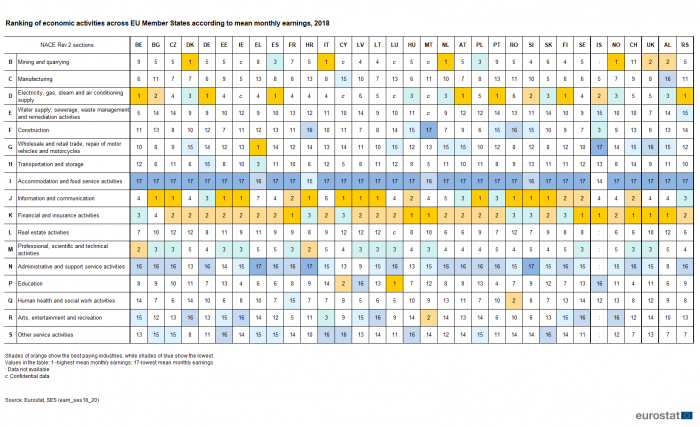Earnings statistics
Data extracted in March 2021.
Planned article update: 17 January 2025.
Highlights
This article analyses the results of the four-yearly structure of earnings survey (SES) that provides comparable in-depth information at European Union (EU) level on the link between the level of earnings and the individual characteristics of employees (sex, age, occupation, educational level) and their employer (economic activity, size of the enterprise, etc.).
Full article
General overview
The SES is a large enterprise survey providing detailed information on the structure and distribution of earnings in the EU. The SES is important in compiling other structural indicators such as the gender pay gap, the low-wage trap or the unemployment trap.
The figures below, based on the latest vintage of the SES, relate to October 2018. Data on low-wage earners as well as corresponding median gross hourly earnings refer to all employees (excluding apprentices) working in enterprises with 10 employees or more and which operate in all sectors of the economy except agriculture, forestry and fishing (NACE Rev. 2 section A) and public administration and defence; compulsory social security (NACE Rev. 2 section O). Gross hourly earnings refer to the wages and salaries earned by full-time and part-time employees, per hour paid, in the reference month (generally October 2018) before any tax and social security contributions are deducted. Wages and salaries include any overtime pay, shift premiums, allowances, bonuses, commission, etc.
EU and EA aggregates are compiled as the sum of all Member States except Greece (EL) for which data were not available at the time of drafting this article.
Median gross hourly earnings
Median gross hourly earnings vary by 1 to 11 between Member States when expressed in euro…
As measured in October 2018, median gross hourly earnings expressed in euro show large variations between Member States. The highest median gross hourly earnings were recorded in Denmark (€ 27.2), ahead of Luxembourg (€ 19.6), Sweden (€ 18.2), Belgium and Ireland (€ 18.0 each), Finland (€ 17.5) and Germany (€ 17.2). In contrast, the lowest median gross hourly earnings were registered in Bulgaria (€ 2.4) followed by Romania (€ 3.7), Hungary and Lithuania (€ 4.4 each), Latvia (€ 4.9), Poland (€ 5.0), Croatia and Portugal (€ 5.4 each) as well as in Slovakia (€ 5.6). In other words, across Member States, the highest national median gross hourly earnings was 11 times higher than the lowest when expressed in euro. (Figure 1).

… and by 1 to 4 when expressed in PPS
The highest national median gross hourly earning in October 2018 was 4 times higher than the lowest when expressed in purchasing power standards (PPS), which eliminates price level differences between countries. The highest median gross hourly earnings in PPS were recorded in Denmark (19.2 PPS), ahead of Germany (16.1 PPS), Belgium (15.7 PPS), Luxembourg (15.1 PPS), Sweden (14.7 PPS) and the Netherlands (14.3 PPS). At the opposite end of the scale, the lowest median gross hourly earnings were registered in Bulgaria (4.6 PPS) followed by Portugal (6.0 PPS), Latvia (6.4 PPS), Lithuania (6.5 PPS), Hungary (6.8 PPS) and Romania (6.9 PPS). (Table 1).

Low-wage earners
Low-wage earners are defined as those employees earning two thirds or less of the national median gross hourly earnings. Hence, the threshold that determines low-wage earners is relative and specific to each Member State.
Almost one in every six employees in the European Union is a low-wage earner
In 2018, 15.3 % of employees in the European Union (EU) were low-wage earners compared to 16.4 % in 2014. 18.2 % of female employees were low-wage earners, compared with 12.5 % of male employees.
Highest share of low-wage earners in Latvia, lowest in Sweden
In 2018, the proportion of low wage earners continued to vary significantly between Member States. The highest percentages were observed in Latvia (23.5 %), Lithuania (22.3 %), Estonia (22.0 %) , Poland (21.9 %), followed by Bulgaria (21.4 %), Germany (20.7 %) and Romania (20.0 %). In contrast, less than 10 % of employees were low wage earners in Sweden (3.6 %), Portugal (4.0 %), Finland (5.0 %), Italy (8.5 %), France (8.6 %) and Denmark (8.7 %). (Figure 2)

Expressed in national currency, the low wage thresholds are per hour: Bulgaria: BGN 3.1; Czechia: CZK 105.5; Denmark: DKK 135.3; Croatia: HRK 26.6; Hungary: HUF 929.4; Poland: PLN 14.1; Romania: RON 11.6; Sweden: SEK 124.3; United Kingdom: GBP 9.0; Iceland: ISK 1957.0; Norway: NOK 168.3; Albania: ALL 146.9; Serbia: RSD 221.2.
Low-wage earners by age groups, level of education, type of contract and NACE section, 2018
More than a quarter (26.3 %) of employees aged less than 30 were low wage earners, compared with 12.6 % for the age group between 30 and 49 and with 13.9 % for the employees aged 50 and over. The level of education also plays an important role: the lower the level, the higher is the likelihood of being a low-wage earner. In the EU in 2018, 27.1 % of employees with a low education level were low-wage earners. Fewer employees with a medium level of education were low-wage earners (18.0 % of the employees) while only 4.6 % of the employees with a high education level accounted as low-wage earners. The type of contract also has a significant impact. In the EU in 2018, 28.1% % of employees with a contract of limited duration were low-wage earners, compared with 12.8 % of those with an indefinite contract. In 2018, the share of low-wage earners recorded in the EU was highest (39.0 %) in the NACE Rev. 2 section I (‘Accommodation and food service activities’); followed by 33.3 % in section N (‘Administrative and support service activities’) that includes in particular the persons employed by interim agencies.

Distribution of earnings
How are earnings distributed in the EU?
Gross monthly earnings vary sizeably across Member States and economic activities. Notable discrepancies can be observed in the Member States of the European Union (EU) in gross monthly earnings, not only between the 10% of employees earning the least and the 10% earning the most, but also according to the economic activity, with the information and communication sector as well as the financial and insurance activities being among the highest paying industries in every EU Member State and accommodation and food services among the lowest paying.
Disparities in gross monthly earnings within a country can be measured using deciles, and in particular the lowest and highest deciles, which correspond to the 10% of employees earning the least (D1) and to the 10% earning the most (D9). As a consequence, a high D9/D1 interdecile ratio indicates large disparities. D1 is the maximum gross monthly earnings received by the 10% of employees earnings least. D9 is the minimum gross monthly earnings received by the 10% of employees earning most.
Data on distribution of earnings, as well as corresponding median gross monthly earnings refers to all employees (including apprentices) working in enterprises with 10 employees or more and which operate in all sectors of the economy except agriculture, forestry and fishing (NACE Rev. 2 section A) and public administration and defence; compulsory social security (NACE Rev. 2 section O). EU and EA aggregates are compiled as the sum of all Member States.
Largest earnings disparities in Bulgaria, Romania and Latvia
Across the EU Member States in 2018, the D9/D1 dispersion ratio ranged from 2.1 in Sweden to 4.1 in Bulgaria, Romania and Latvia. This means that the 10% best-paid employees earned at least twice as much as the 10% lowest-paid in Sweden, and more than four times as much in the latter three countries. In contrast, the lowest D9/D1 ratios were recorded, after the Nordic countries: Sweden (2.1) and Finland (2.4), in Italy and Belgium (both with a ratio of 2.6) as well as in Denmark (2.7) and France (2.9). The other Member States recorded a ratio between 3.0 and 4.0. Among the EFTA countries the lowest ratio has been observed in Norway (2.4) and the highest in Iceland (2.8). (Figure 4)

Largest gap between high & median wages in Bulgaria and Portugal, between median & low wages in Estonia
The highest disparity on the upper end of the gross monthly earnings distribution in 2018 was registered in Bulgaria and Portugal (with a D9/Median ratio of 2.5). This means that the 10% best paid employees in Bulgaria and Portugal earned two and a half times as much the median. Those two countries are followed by Romania (with a ratio of 2.4), Cyprus (2.3), Luxembourg and Latvia (both with a ratio of 2.2) as well as Ireland, and Hungary (both with a ratio of 2.1). In contrast, Sweden (with a ratio of 1.6) followed by Belgium, Finland and Denmark (all with a ratio of 1.7), recorded the lowest. (Table 2)

For the lower end of the gross monthly earnings distribution, disparities in 2018 were largest in Estonia (with a Median/D1 ratio of 1.9). This means that, in Estonia, the 10% least paid employees earned nearly half of the median earnings. Estonia is followed by Latvia, the Netherlands, Greece, Germany, Lithuania and Poland (all with a ratio of 1.8). At the opposite end of the scale, the lowest disparities in the lower end of distribution were recorded in Sweden (with a ratio of 1.3) as well as in Italy, Portugal and Finland (all with a ratio of 1.4). (Table 2)
And what about economic activities?
To observe differences in earnings between economic activities within each EU Member State gross monthly earnings expressed in euros were used. Gross monthly earnings refer to the wages and salaries earned by full-time and part-time employees in the reference month (generally October 2018) before any tax and social security contributions are deducted. Wages and salaries include any overtime pay, shift premiums, allowances, bonuses, commission, etc. The gross monthly earnings of part-time employees have been converted into full-time units before being included in the calculation.
Finance & insurance and information & communication among the highest paying industries…
On the basis of gross monthly earnings, "Financial and insurance activities" ranked among the 3 highest paying economic activities in every EU Member State, except Bulgaria (where it ranked 4th). It also ranked among the two highest paying sectors among the EFTA countries. The sector "Information and communication" was also largely represented among the top 3 paying industries, with the exceptions of Belgium, Denmark, Spain, Luxembourg and Malta (where it ranked 4th), the Netherlands (5th position), Italy (6th position) and Greece (7th place). (Table 3)

"Electricity, gas, steam and air conditioning supply" was the best paying industry in Belgium, Germany, Spain, Austria, Portugal and Finland and ranked second in Bulgaria as well as in Slovenia. "Mining and quarrying" ranked first in Denmark, Italy and the Netherlands and third in Spain and Poland. As for "Education", it was the best paying economic activity in Luxembourg and the second in Cyprus. Finally, "Professional ,scientific and technical activities" ranked among the 2 highest paying industries in Belgium and Croatia. (Table 3)
… Accommodation & food and Administrative and support services among the lowest paying
At the opposite end of the ranking, "Accommodation and food service activities" was identified in 2018 as the lowest paying activity of the economy in all Member States except Greece, Malta and Slovenia (last but one position) and Croatia (last but two). "Administrative and support service activities" also ranked widely in the bottom 3, with the exceptions of Estonia (last but 3 position), as well as of Denmark, Cyprus and Hungary (last but 4) and Latvia. (Table 3)
Data sources
The Structure of earnings survey (SES) is carried out with a four-yearly periodicity according to Regulation (EC) No 530/1999. The most recent available reference years for the SES are 2002, 2006, 2010, 2014 and 2018. The data collection is based on legislation and data become available approximately 2 years after the end of the reference period.
National statistical offices collect the information on relationships between the level of earnings, individual characteristics of employees (sex, age, occupation, length of service, educational level) and the characteristics of their employer (economic activity, size of the enterprise, etc.) - the enterprise.
The statistics of the SES refer to enterprises employing at least 10 employees in all areas of the economy except agriculture, forestry and fishing (NACE Rev. 2 section A) and public administration and defence; compulsory social security (NACE Rev. 2 section O). Economic activites are classified using the Statistical classification of economic activities in the European Community (NACE). SES 2002 and 2006 are classified in NACE Rev.1.1 whereas SES 2010, 2014 and 2018 are classified in NACE Rev.2. The inclusion of section L (in 2002 and 2006) and section O (in 2010, 2014 and 2018), as well as the inclusion of enterprises with less than 10 employees, is optional.
Occupations are coded according to the International standard classification of occupations, 1988 - ISCO-88 (COM) in 2002 and 2006 whereas in SES 2010, 2014 and 2018 are coded in ISCO-08.
The variable 'Highest successfully completed level of education and training' in SES 2014 and 2018 is classified using the International standard classification of education, 2011 version (ISCED 11) and the education level groupings are as follows: Low level: ISCED 0, 1 and 2 (Early childhood education (‘less than primary’ for educational attainment); Primary education; Lower secondary education), Medium level: ISCED 3 and 4 (Upper secondary education and post-secondary non-tertiary education), and High level: ISCED 5a, 5b and 6 (Short-cycle tertiary education; Bachelor’s or equivalent level; Master’s or equivalent level and Doctoral or equivalent level). For SES 2002, 2006 and 2010 International standard classification of education, 1997 version (ISCED 97) was used.
The regional breakdown is based on the Nomenclature of territorial units for statistics (NUTS).
Context
The main reasons for initiating the European Structure of earnings survey (SES) were set out in Regulation (EC) No 530/1999 of 9 March 1999 concerning structural statistics on earnings and on labour costs. The objective of the Regulation (EC) No 530/1999 and the related Commission Regulation (EC) No 1738/2005 in this domain is to provide accurate and harmonised data on earnings in the EU Member States, EFTA countries and candidate countries for policy-making and research purposes.
The SES is a large scale enterprise sample survey that provides detailed and Europe wide comparable information on relationships between the level of remuneration, individual characteristics of employees (sex, age, occupation, length of service, highest educational level attained, etc.) and their employer (economic activity, size and location of the enterprise).
Users of the SES want to determine the earnings received by employees and to investigate the statistical relationship between the level of the earnings and the individual characteristics of the employees and the characteristics of the employer.
The SES represents a rich microdata source for European policy-making and research purposes. Access to microdata is granted to researchers according to specific conditions and respecting statistical confidentiality.
Direct access to
- Structure of earnings survey 2014 (earn_ses2014)
- Gender pay gap in unadjusted form (earn_grgpg)
- Development of econometric methods to evaluate the Gender pay gap using Structure of Earnings Survey data (Working paper)
- Gender pay gap in unadjusted form - Nace rev.2 (ESMS metadata file — earn_grgpg2_esms)
- Structure of earnings survey 2014 (ESMS metadata file — earn_ses2014_esms)
- A Roadmap for equality between women and men 2006-2010 (Commission Communication SEC(2006) 275)
- Equality between women and men — 2010 (Report from the Commission SEC(2009)1706)
- Strategy for equality between women and men 2010-2015 (Commission Communication COM/2010/0491 final)
- Regulation (EC) No 530/1999 of 9 March 1999 concerning structural statistics on earnings and on labour costs
- Summaries of EU Legislation: Statistics on earnings and labour costs
- Regulation (EC) No 1738/2005 of 21 october 2005 amending Regulation (EC) No 1916/2000 as regards the definition and transmission of information on the structure of earnings
